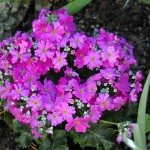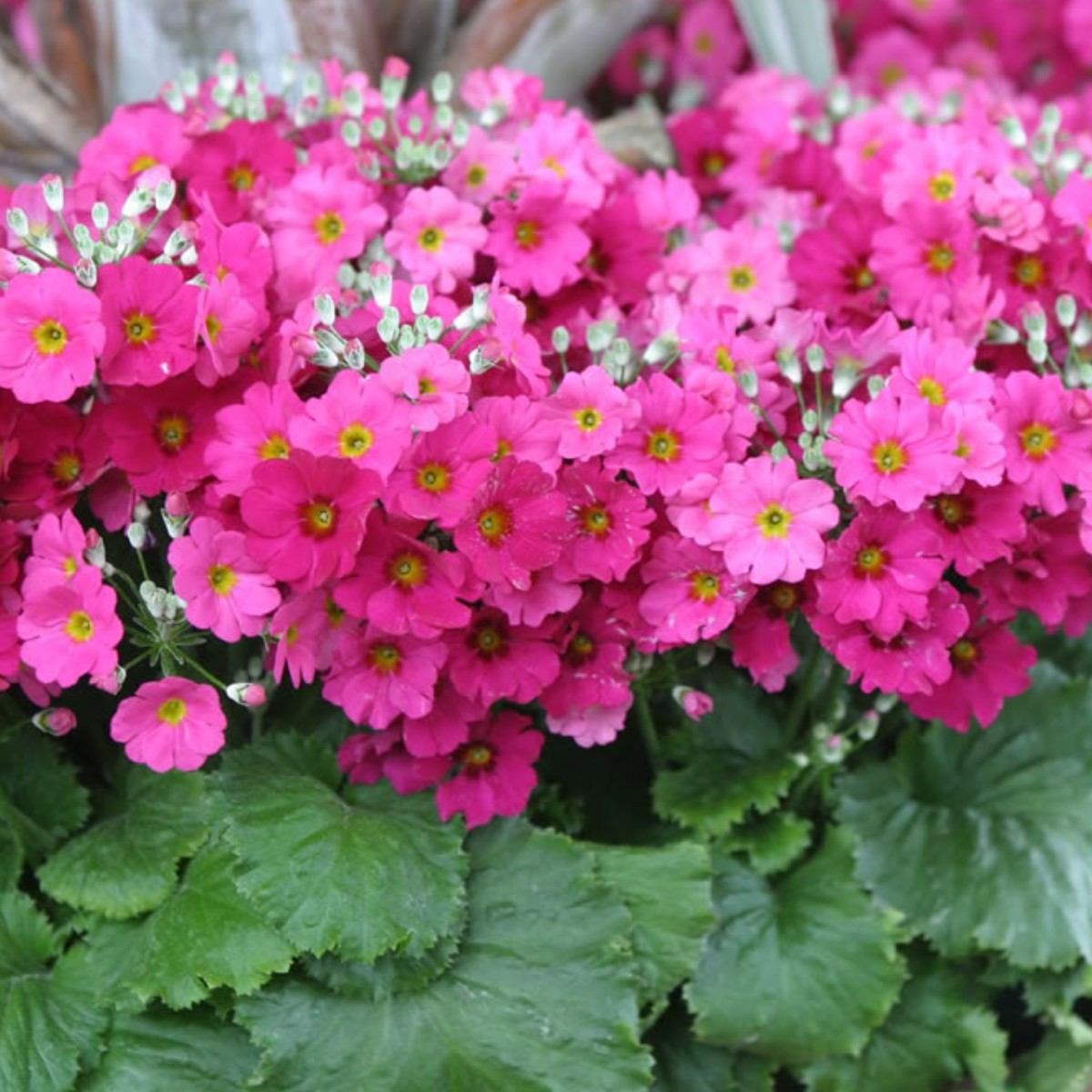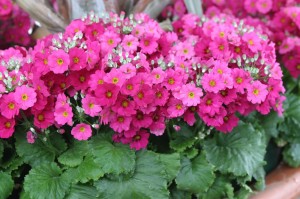Family: Primulaceae
Synonymous: Primula delicata
Primula forbesii subsp. delicata
Primula malacoides subsp. pseudomalacoides
Primula pseudomalacoides
Distribution and habitat: Primula malacoides is an evergreen perennial plant native to Yunnan province of China. This plant was naturalized in many parts of the world where it has adapted successfully to sub-tropical alpine climates.
The word primula is the Latin feminine diminutive of primus, meaning first (prime), applied to flowers that are among the first to open in spring.
Description: Primula malacoides is a small mauve-flowered wild species. There are some forms with bright pink, red or white flowers. The plants form a foliage rosette 20 to 40cm (8-16 inch) high and 30cm (1 feet) wide; soft, pale green, oval, 4 to 8cm (1.5 - 3 inch) long leaves, with lobed and cut edges are carried on long stalks. From midwinter to spring the best of these forms carry between 20 and 30 blooms in tiers, on slender stems above hairy, pale green, scallop-edged leaves. Tiered blossoms in loose, lacy whorls along many upright stems.
Houseplant care: Although they are perennial, they make a quite effective indoor plants, most treated as annuals to be enjoyed while in bloom and then disposed of. Those that are to be carried over to another season, require cool, light shade and airy conditions during the summer, with just enough water to prevent the mixture from drying out. Alternatively, in areas within its hardiness zone, these plants can be transplanted into the ground when they finish blooming and enjoy them for several years.
The flowering season can be prolonged by picking off dead flowers as soon as they fade.
Light: Bright light, including some sunshine must be provided for Primula malacoides at all times. They make a wonderful plant for window sills. Turn the pots regularly so stems grow strait and tall.
Temperature: Primula malacoides purchased already in flower are best kept between 10-13C (50-55F). Room temperature over 15C (59F) will shorten the life of the flowers. If plants are brought into warmer room temporarily, give them added humidity by standing them on trays of moist pebbles and mist-spray the plants frequently.
Reduce the temperature if individual flowers only last a couple of days.
Watering: Water plentifully, enough to keep the entire potting mixture thoroughly moist, but never let the pot stand in water.
Feeding: Apply standard liquid fertiliser every two weeks during the entire flowering period.
Potting and repoting: Use a soil based potting mixture. Small plants, which can usually be bought in early autumn, should be quickly moved into 10 or 13cm (4-5 inch) pots to give them room for development.
Gardening: Young plants of Primula malacoides are more productive of blooms than the old ones and hence it is desirable to raise these plants from seeds each year. Ideal the temperature in summer should be 16C (61F), in winter should be 5 to 10C (41-50F).
The stems of Primula malacoides should be removed after flowering in order to promote new growth.
Position: Primula malacoides are perfect for shady areas although they can tolerate dappled morning sun. It is a plant that thrives in the cool, short days of winter and early spring.
Soil: They prefer soil that is rich in organic matter so it is important to add compost to the soil before planting. Its ideal setting is woodland with soil that is rich in humus and remains moist throughout the year, but is also well drained.
Plant Primula malacoides 20 to 25cm (8-10 inch) apart one from another. Water the plants before removing from their pot to plant them in beds. Water again next morning the new planted Primula malacoides.
Irrigation: Primula malacoides prefers moist to wet soil and will grow well in almost any setting provided if it is kept well watered. Keep the soil moist, but not sodden and pay particular attention to watering if these plants are grown in pots or baskets. Primula malacoides do not like to get thirsty.
If the weather turns too warm, mulch around the plants with compost to help keep the root systems cool.
Fertilising: This plant has moderate feeding requirements. If in beds, a soluble multi-feed, used every six weeks is adequate. Monthly feeding is preferable if in containers or hanging baskets. This feeding will ensure prolific blooming and healthy, strong plants.
Propagation: Primula malacoides are prolific self seeders. They can be propagated by sowing when seeds are ripe or by division in late summer.
The seeds are small and special care should be taken for sowing small seeds. Sow them using a peaty potting mix. These seeds need light for germination, so barely cover with soil. Watering the seeds pans should be done from bellow: the water is placed in a trough of water and it is absorbed through the drainage holes. Keep seeds moist until germination. The germination, which is irregular, is completed in two to three weeks. When the seedling are large enough to be handled with ease, they should fist transplanted to 8cm (3 inch), then finally in beds or 13cm (4 inch) pots. To pot them, use same potting mixture as for mature plants. The plants raised from seeds will flower in about six months - Seeds are sown in autumn and the plants will flower in spring. Begin to feed when the flower stalks begin to develop and continue to feed at intervals of 14 days until flowering has finished.
Problems:
Honeydew, galls and distorted leaves are a sign for an infestation with aphids.
Treatment: Use an adequate insecticide. Outdoors biological control can be an alternative, introducing parasitic wasps or predators such as Aphidoletes aphidimyza.
A powdery white coat on the plants indicates an infection with powdery mildew.
Treatment: Remove affected plants and apply a fungicide. To prevent infection improve ventilation, keep the roots moist and do not water the plants from above.
White tufts or white covering on the lower surface of the leaves indicates an infection with downy mildew.
Treatment: Remove affected plants and apply a fungicide. To prevent infection improve ventilation, keep the roots moist and do not water the plants from above.
Fine webs on the plants indicate an infestation with red spider mites. These sap-sucking insects mainly appear under glass.
Treatment: These pests can be controlled either with insecticide or outdoors can be controlled biologically with parasitic mites.
Sudden wilting and pale green discolouration indicate a fungal infection (phytophthora).
Treatment: Remove infected plants. Avoid it by improving drainage and do not over-fertilise these plants.
Gnaw marks and slime trails indicate a problem with slugs.
Treatment: Prevent infestation by improving hygiene and by regularly working the soil. In case of an infestation use slug pellets or nematodes to control pest. Handpicking the slug also helps, do this preferably in the evening hours.
Primula malacoides are eaten by the larvae (caterpillars) of some Lepidoptera species, including Duke of Burgundy butterfly, Large Yellow Underwing, Lesser Broad-bordered Yellow Underwing, Setaceous Hebrew Character and Silver-ground Carpet.
Treatment: Use an adequate pesticide.
Disfigured and discoloured leaves and flowers indicate a viral infection.
Treatment: Remove affected plants. Keep the plants pest free as they may spread the disease.
Companion plants: Primula malacoides show to great effect in striking mass displays, as companion plants to spring-flowering bulbs such as Tulipa species and mixed with viola species, pansy (Viola tricolor subsp. hortensis), Phlox species and Iceland poppies (Papaver nudicaule) in sparkling herbaceous borders. They make a wonderful display in front of the Iris species beds, sharing the same cool and humid habitat.
Availability: Primula malacoides become available as flowering pots from the florists and nurseries centres during midwinter till early spring.
Toxicity: The leaves may irritate the skin. Use garden gloves when handling these plants.
Uses and display: Primula malacoides is a perennial in mildest winters but treated as an annual, potted plant or houseplant everywhere. These plants are good planted in rock gardens, used as bedding plants and in containers. They are suited for cultivation in a cold house. Also they are very appreciated as indoor plant for their colourful early blooms.
They are good plants for the woodland garden and for a wonderful display when planted en masse, creating a meadow in the garden. Due to their height, they are a good filler for the middle to back section of flower beds. Primula malacoides are wonderful for attracting butterflies. In containers and hanging baskets they can be used to create a vertical accent. Primroses look terrific when displayed in baskets. Place several small pots of primulas in a large basket and fill in the space between the pots with moss.
Primula malacoides, together with all Primula species, provide relief from a somewhat barren winter landscape. Their sea of dreamy colours is a must have when planting a winter garden.
SUMMARY:
CHARACTERISTICS:
Foliage green
Shape rosette
Features - flowers
Height: 30cm (12 inch)
Width: 20cm (8 inch)
PROPER CARE:
Watering in active growth period plentifully
Light bright
Temperature in active growth period min 7C max 18C (45-64F)
Humidity high
Hardiness zone: 8-11






